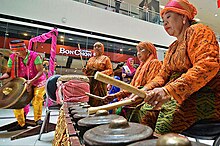Kagan / Kaagan | |
|---|---|
 The Kagans of Davao City playing the Kulintang | |
| Total population | |
| 87,327 (2020 census) | |
| Regions with significant populations | |
| Languages | |
| Kalagan, Cebuano, Filipino | |
| Religion | |
| Predominantly Islam, (Animism, & Indigenous Folk Religion) | |
| Related ethnic groups | |
| Maguindanaon, Tagakaulo, Lumad, Mansaka, Mandaya, Austronesian |
The Kalagan (also spelled Kagan, Kaagan, or by the Spanish as Caragan) are a subgroup of the Mandaya-Mansaka people who speak the Kalagan language. The Kalagan comprise three subgroups which are usually treated as different tribes: the Tagakaulo, the Kagan, and the Kal’lao people of Samal. They are native to areas within Davao del Sur, Compostela Valley, Davao del Norte (including Samal Island), Davao Oriental, and North Cotabato; between the territories of the Blaan people and the coastline. They were historically composed of small warring groups.[1] They are renowned as agriculturalists, cultivating rice, corn, abaca, and coconut for cash crops, whereas their counterparts living along the coast practice fishing.
The "Kalagan" or "Kaagan" or "Kagan: the name came from the native word "Kaag", which means "fellow" and the other meaning is "to inform" or "secrecy" because they are the people who bring the news and warn their neighbouring tribes ( the Mansaka and Mandayas) on any types of attacks from the other ethnic groups since they are living on shorelines and river deltas of Davao Gulf, on which they are the first one who can encounter on whatever attacks or conquering happen. They were historically composed of small groups led by datus.[2]
The Kagan subgroup is the Islamized-indigenous people in the Davao Gulf area. They are one of the Muslim minority groups in Mindanao and belong to the 13 Muslim Moro tribes of the Bangsamoro family. They became Muslim in the middle of the 19th century due to extensive exposure or contact with the communities of their Maguindanaon neighbors, and intermarriages between Kalagan and Maguindanaons.[3] Thus making Islamized Kagan heavily influenced by Maguindanaon culture.
- ^ "Peoples of the Philippines: Kalagan". National Commission for Culture and the Arts. Republic of the Philippines. Retrieved 26 October 2019.
- ^ "Peoples of the Philippines: Kalagan". National Commission for Culture and the Arts. Republic of the Philippines. Retrieved 26 October 2019.
- ^ Cite error: The named reference
Kalaganwas invoked but never defined (see the help page).
